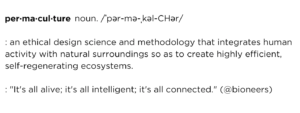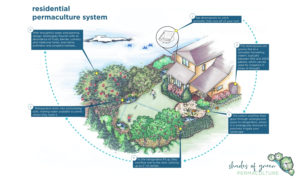The step forward begins at our own front door.
What does permaculture mean?
Permaculture is a portmanteau of the words “permanent” and “agriculture” that points to creating lasting and productive systems that yield food, fiber, and fuel year over year.
The definition I like to use is:

When can you use permaculture?
Permaculture as a design methodology can be applied to any system, land-based or otherwise. How permaculture is applied changes depending on the context.
As we’re based in an urban/suburban center (Atlanta) in the temperate southeast United States, the way we apply permaculture may look different from how it is applied on a rural farm on the arid West Coast, for instance. It is important to first understand the patterns that form the foundation of regenerative human development, and from there we can make incremental changes in our own landscapes that mimic natural systems and help forward the work of earth repair.
How does permaculture work?
Fundamentally, permaculture seeks to integrate human needs and activities with the needs and yields of natural ecosystems. For urban/suburban dwellers, this looks like three primary focus areas: restoring the water cycle, building soil fertility, and cultivating productive and native plant communities.
Here is a permaculture approach to a typical residential space that incorporates these three tenets:

What are the permaculture principles?
Depending on who you’re talking to, there are between 12 and 24 Permaculture Principles. I guess this is what happens with a decentralized grassroots approach, and whether you fancy yourself a “lumper” or a “splitter” (a little botanical humor for ya).
Personally, I’m a lumper, so I consider there to be 12 primary permaculture principles, which are based on the laws that govern natural systems. I’ll do a deep dive into these principles in another post.
Wondering where to start?
If you’re looking for ways to deepen your knowledge, where to learn permaculture, or how to get started, we have a few great resources for you:
- The best first place to start is with site observation. Consider downloading our free guide: How to Read Your Site.
- We also have a resource list full of books, organizations, articles, and more that are organized by topic in our Additional Resources Guide.
- If you’re more of a learn-by-doing type, we can guide you through our Virtual Coaching offering, where we look at your site with you and give you direction and resources to begin implementing permaculture on your own, with a little expert guidance.
- And if you REALLY want to do a deep dive and learn the nuts and bolts behind working with water, soils, and plants, we’re launching Beginning with Home: Climate Solutions from the Ground Up this fall.
Thanks for following along, and please shoot me an email with specific questions you have as they come up, as I would love to address these in future posts!